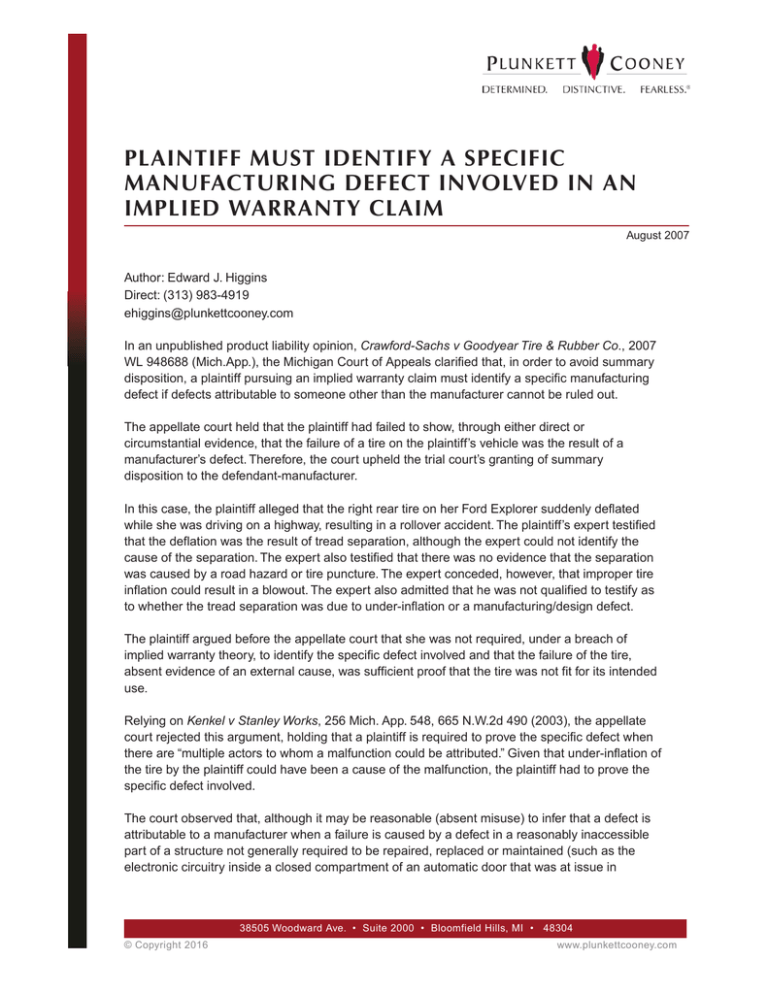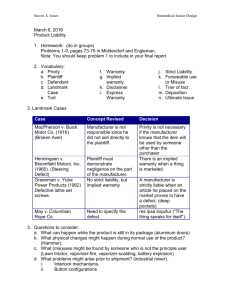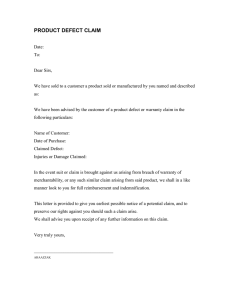
PLAINTIFF MUST IDENTIFY A SPECIFIC
MANUFACTURING DEFECT INVOLVED IN AN
IMPLIED WARRANTY CLAIM
August 2007
Author: Edward J. Higgins
Direct: (313) 983-4919
ehiggins@plunkettcooney.com
In an unpublished product liability opinion, Crawford-Sachs v Goodyear Tire & Rubber Co., 2007
WL 948688 (Mich.App.), the Michigan Court of Appeals clarified that, in order to avoid summary
disposition, a plaintiff pursuing an implied warranty claim must identify a specific manufacturing
defect if defects attributable to someone other than the manufacturer cannot be ruled out.
The appellate court held that the plaintiff had failed to show, through either direct or
circumstantial evidence, that the failure of a tire on the plaintiff’s vehicle was the result of a
manufacturer’s defect. Therefore, the court upheld the trial court’s granting of summary
disposition to the defendant-manufacturer.
In this case, the plaintiff alleged that the right rear tire on her Ford Explorer suddenly deflated
while she was driving on a highway, resulting in a rollover accident. The plaintiff’s expert testified
that the deflation was the result of tread separation, although the expert could not identify the
cause of the separation. The expert also testified that there was no evidence that the separation
was caused by a road hazard or tire puncture. The expert conceded, however, that improper tire
inflation could result in a blowout. The expert also admitted that he was not qualified to testify as
to whether the tread separation was due to under-inflation or a manufacturing/design defect.
The plaintiff argued before the appellate court that she was not required, under a breach of
implied warranty theory, to identify the specific defect involved and that the failure of the tire,
absent evidence of an external cause, was sufficient proof that the tire was not fit for its intended
use.
Relying on Kenkel v Stanley Works, 256 Mich. App. 548, 665 N.W.2d 490 (2003), the appellate
court rejected this argument, holding that a plaintiff is required to prove the specific defect when
there are “multiple actors to whom a malfunction could be attributed.” Given that under-inflation of
the tire by the plaintiff could have been a cause of the malfunction, the plaintiff had to prove the
specific defect involved.
The court observed that, although it may be reasonable (absent misuse) to infer that a defect is
attributable to a manufacturer when a failure is caused by a defect in a reasonably inaccessible
part of a structure not generally required to be repaired, replaced or maintained (such as the
electronic circuitry inside a closed compartment of an automatic door that was at issue in
38505 Woodward Ave. • Suite 2000 • Bloomfield Hills, MI • 48304
© Copyright 2016
www.plunkettcooney.com
Kenkel), the tire in this case was not such an inaccessible part. Therefore, the plaintiff was not
entitled to such an inference of manufacturers’ defect.
Recent federal district court decisions had suggested that Michigan product liability law did not
require the plaintiff to specify a particular defect when proceeding under an implied warranty
theory, thereby negating any requirement to offer expert testimony or employ the risk-utility test.
The In Summary Newsletter is distributed by the firm of Plunkett Cooney. Any questions or
comments concerning the matters reported may be addressed to Patrick D. Ryan or any other
members of the practice group. The brevity of this newsletter prevents comprehensive treatment
of all legal issues, and the information contained herein should not be taken as legal advice.
Advice for specific matters should be sought directly from legal counsel. Copyright© 2007. All
rights reserved PLUNKETT COONEY, P.C.
38505 Woodward Ave. • Suite 2000 • Bloomfield Hills, MI • 48304
© Copyright 2016
www.plunkettcooney.com




